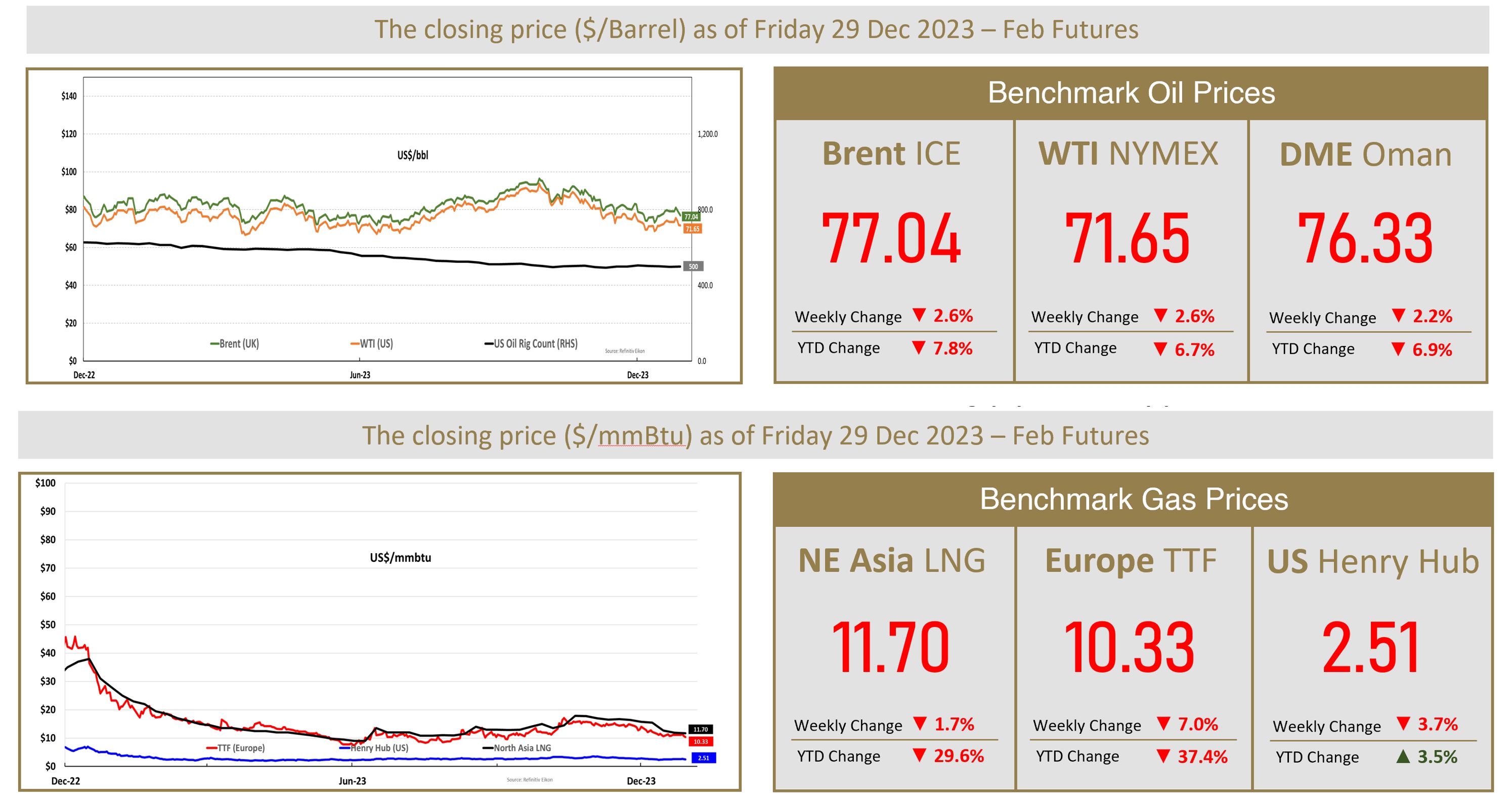
403
Sorry!!
Error! We're sorry, but the page you were looking for doesn't exist.
Oil Prices Shed 10% In 2023 as Supply, Demand Concerns Weigh
(MENAFN- The Al-Attiyah Foundation) Crude futures lost over 10% in 2023 in a tumultuous year of trading marked by geopolitical turmoil and concerns about the oil output levels of major producers around the world. Brent crude on Friday, the last trading day of the year, settled at $77.04 a barrel, down 11 cents or 0.14%. U.S. West Texas Intermediate crude settled at $71.65 a barrel, down 12 cents or 0.17%. Both contracts slipped more than 10% in 2023 to close out the year at their lowest year-end levels since 2020. Meanwhile, OPEC is facing weakening demand for its crude in the first half of 2024 just as its global market share declines to the lowest level since the pandemic on output cuts and Angola's exit from the group. The war in the Middle East prompted jitters about potential supply disruptions in the final few months of 2023 that are expected to last into 2024. Geopolitical tensions in the Middle East escalated on the last day of 2023 as Israel intensified its attacks in southern Gaza, putting upward pressure on prices. In the U.S., crude oil output fell slightly in October to 13.248 million barrels per day, after it set monthly records in August and September. Energy firms this week added oil and natural gas rigs for the first time in three weeks.
Asia Spot LNG Price Remains at 4-month Low, Falls 58% In 2023
Asian spot liquefied natural gas (LNG) prices remained at their lowest level in over four months this week on strong inventories, mild weather and weak demand which are all bearish factors that are seen continuing into 2024. The average LNG price for February delivery into north-east Asia fell slightly to $11.70 per million British thermal units (mmBtu) from $11.90 last week, remaining at its lowest level since August 13, industry sources estimated. The price has fallen 58% this year as demand remained muted most of the year in both Asia and Europe. In north-east Asia, mild weather across most of the region after a recent cold snap is limiting demand for additional spot purchases, particularly in South Korea, which is set to see a prolonged period of above-average temperatures. On the export side, ICIS data shows the U.S. LNG exports rose by around 12% in 2023 to 87.0 million metric tons from 77.5 million metric tons in 2022. In Europe, weather forecasts have been revised as lower-than-normal temperatures are expected after the first week of January, but the continent still has record gas storage inventories, as well as strong pipeline supplies and LNG flows.
By: The Al-Attiyah Foundation.
Asia Spot LNG Price Remains at 4-month Low, Falls 58% In 2023
Asian spot liquefied natural gas (LNG) prices remained at their lowest level in over four months this week on strong inventories, mild weather and weak demand which are all bearish factors that are seen continuing into 2024. The average LNG price for February delivery into north-east Asia fell slightly to $11.70 per million British thermal units (mmBtu) from $11.90 last week, remaining at its lowest level since August 13, industry sources estimated. The price has fallen 58% this year as demand remained muted most of the year in both Asia and Europe. In north-east Asia, mild weather across most of the region after a recent cold snap is limiting demand for additional spot purchases, particularly in South Korea, which is set to see a prolonged period of above-average temperatures. On the export side, ICIS data shows the U.S. LNG exports rose by around 12% in 2023 to 87.0 million metric tons from 77.5 million metric tons in 2022. In Europe, weather forecasts have been revised as lower-than-normal temperatures are expected after the first week of January, but the continent still has record gas storage inventories, as well as strong pipeline supplies and LNG flows.
By: The Al-Attiyah Foundation.

Legal Disclaimer:
MENAFN provides the
information “as is” without warranty of any kind. We do not accept
any responsibility or liability for the accuracy, content, images,
videos, licenses, completeness, legality, or reliability of the information
contained in this article. If you have any complaints or copyright
issues related to this article, kindly contact the provider above.

















Comments
No comment